Atmospheric Concentration of Particulate Air Pollutants in the Context of Projected Future Emissions from Motor Vehicles
Abstract
1. Introduction
- Basic Scenario—representing the current vehicle fleet composition;
- Euro 7 Scenario—assuming the same number of vehicles as in the Basic scenario, but all vehicles meet Euro 7 standards, and buses and trucks meet Euro VII standards;
- BEV Scenario—assuming that all vehicles are battery electric vehicles (BEVs).
2. Materials and Methods
- Average driving speed V = 27 km/h (this represents the average speed value determined using the OBD system in a vehicle operated within the analyzed area of Rzeszow County over a one-year period);
- Average load of a truck/bus 50%;
- Average annual mileage of a passenger car 10,000 km;
- Average annual mileage of a truck 20,000 km;
- Average annual mileage of a bus 60,000 km;
- Average annual mileage of a motorcycle/moped 5000 km.
3. Results and Discussion
4. Conclusions
- The replacement of vehicles with low-emission ones (Euro 7) may contribute to a reduction in PM2.5 dust emissions by about 52% in the Rzeszow district, and PM10 dust emissions by about 55%.
- Replacing internal combustion engine vehicles with BEV (battery electric vehicle) electric vehicles could reduce PM2.5 dust emissions by about 58% and PM10 dust emissions by about 54% in the analyzed district.
- Considering the additional indirect emissions associated with electricity production, the reduction in PM2.5 dust emissions for the BEV scenario would be approximately 54%, and PM10 dust emissions would be about 50%.
- Replacing internal combustion engine vehicles with electric vehicles is associated with a significant reduction in emissions of gaseous pollutants (NOx, CO, CO2, THC, etc.). However, eliminating internal combustion engine vehicles will not significantly reduce particulate pollution levels. When comparing emissions for the Euro 7 and BEV scenarios, replacing internal combustion engine vehicles with electric ones could reduce PM2.5 dust emissions by about 6% (around 2% considering indirect emissions from electricity production for battery charging), and PM10 dust emissions by about 10% (around 5% considering indirect emissions).
Supplementary Materials
Author Contributions
Funding
Institutional Review Board Statement
Informed Consent Statement
Data Availability Statement
Acknowledgments
Conflicts of Interest
References
- Targa, J.; Colina, M.; Banyuls, L.; González Ortiz, A.; Soares, J. Status Report of Air Quality in Europe for Year 2024, Using Validated and Up-to-Date Data (ETC-HE Report 2025/1); European Topic Centre on Human Health and the Environment: Truro, UK, 2024. [Google Scholar] [CrossRef]
- Ortega, J.L.M.; Akkermans, S.; Lopez, P.; Chornet, J.; Petrides, Y.R.; Vella, A.; Dauwe, T.; Ebrahimi, B.; Bouman, E.; Moran, D.D. ETC CM Report 2024/03. European Topic Centre on Climate Change Mitigation. 2024. Available online: https://www.eionet.europa.eu/etcs/etc-cm/products/etc-cm-report-2024-03/%40%40download/file/ETC%2520Report%25202024-03%2520(1).pdf (accessed on 29 April 2025).
- Jamrozik, A.; Tutak, W.; Gruca, M.; Pyrc, M. Performance, emission and combustion characteristics of CI dual fuel engine powered by diesel/ethanol and diesel/gasoline fuels. J. Mech. Sci. Technol. 2018, 32, 2947–2957. [Google Scholar] [CrossRef]
- Jaworski, A.; Kuszewski, H.; Balawender, K.; Woś, P.; Lew, K.; Jaremcio, M. Assessment of CH4 Emissions in a Compressed Natural Gas-Adapted Engine in the Context of Changes in the Equivalence Ratio. Energies 2024, 17, 2095. [Google Scholar] [CrossRef]
- Giechaskiel, B.; Grigoratos, T.; Mathissen, M.; Quik, J.; Tromp, P.; Gustafsson, M.; Franco, V.; Dilara, P. Contribution of Road Vehicle Tyre Wear to Microplastics and Ambient Air Pollution. Sustainability 2024, 16, 522. [Google Scholar] [CrossRef]
- Laskowski, P.P.; Zimakowska-Laskowska, M. The problem of emission of total particulate matter and heavy metals from tribological systems in vehicles. Combust. Engines 2024, 198, 13–19. [Google Scholar] [CrossRef]
- Grigoratos, T.; Fontaras, G.; Giechaskiel, B.; Zacharof, N. Real world emissions performance of heavy-duty Euro VI diesel vehicles. Atmospheric Environ. 2019, 201, 348–359. [Google Scholar] [CrossRef]
- Pielecha, J.; Merkisz, J.; Markowski, J.; Jasiński, R.; Filipowicz, M.; Dudek, M.; Olkuski, T.; Styszko, K. Analysis of Passenger Car Emission Factors in RDE Tests. In Proceedings of the E3S Web of Conferences, Poznan, Poland, 17–19 May 2016; Volume 10, p. 00073. [Google Scholar] [CrossRef]
- Ziółkowski, A.; Fuć, P.; Lijewski, P.; Jagielski, A.; Bednarek, M.; Kusiak, W. Analysis of Exhaust Emissions from Heavy-Duty Vehicles on Different Applications. Energies 2022, 15, 7886. [Google Scholar] [CrossRef]
- Lijewski, P.; Merkisz, J.; Fuć, P.; Ziółkowski, A.; Rymaniak, L.; Kusiak, W. Fuel consumption and exhaust emissions in the process of mechanized timber extraction and transport. Eur. J. For. Res. 2017, 136, 153–160. [Google Scholar] [CrossRef]
- Gis, W.; Gis, M.; Pielecha, J.; Skobiej, K. Alternative Exhaust Emission Factors from Vehicles in on-Road Driving Tests. Energies 2021, 14, 3487. [Google Scholar] [CrossRef]
- Mattonai, M.; Nacci, T.; Modugno, F. Analytical strategies for the quali-quantitation of tire and road wear particles. A critical review. Trends Anal. Chem. 2022, 154, 116650. [Google Scholar] [CrossRef]
- Beji, A.; Deboudt, K.; Muresan, B.; Khardi, S.; Flament, P.; Fourmentin, M.; Lumiere, L. Physical and chemical characteristics of particles emitted by a passenger vehicle at the tire-road contact. Chemosphere 2023, 340, 139874. [Google Scholar] [CrossRef]
- Koupal, J.; Denbleyker, A.; Kishan, S.; Vedula, R.; Agudelo, C. Brake Wear Particulate Matter Emissions Modelling; Eastern Research Group, Inc.: Concord, MA, USA; LINK Engineering Company: Plymouth, MI, USA, 2021; p. CA21-3232. Available online: https://rosap.ntl.bts.gov/view/dot/60273 (accessed on 24 May 2024).
- Seihei, N.; Farhadi, M.; Takdastan, A.; Asban, P.; Kiani, F.; Mohammadi, M.J. Short-term and long-term effects of exposure to PM10. Clin. Epidemiology Glob. Heal. 2024, 27, 101611. [Google Scholar] [CrossRef]
- Sjödahl, K.; Jansson, C.; Bergdahl, I.A.; Adami, J.; Boffetta, P.; Lagergren, J. Airborne exposures and risk of gastric cancer: A prospective cohort study. Int. J. Cancer 2007, 120, 2013–2018. [Google Scholar] [CrossRef] [PubMed]
- Sangkham, S.; Phairuang, W.; Sherchan, S.P.; Pansakun, N.; Munkong, N.; Sarndhong, K.; Islam, A.; Sakunkoo, P. An update on adverse health effects from exposure to PM2.5. Environ. Adv. 2024, 18, 100603. [Google Scholar] [CrossRef]
- Krzeszowiak, J.; Pawlas, K. Particulate matter (PM2,5 and PM10), properties and epidemiological significance for respiratory and cardiovascular diseases. A review of the literature on the effects of short- and long-term exposure. Med. Sr. Environ. Med. 2018, 21, 7–13. Available online: https://www.environmed.pl/pdf-112798-42572?filename=Particulate%20matter%20_PM2_5.pdf (accessed on 29 April 2025).
- Particulate matter from natural sources and related reporting under the EU Air Quality Directive in 2008 and 2009. In EEA Technical Report No 10/2012; Publications Office of the European Union: Luxembourg, 2012. [CrossRef]
- Fuć, P.; Lijewski, P.; Kurczewski, P.; Ziołkowski, A.; Dobrzyński, M. The analysis of fuel consumption and exhaust emissions from forklifts fueled by diesel fuel and liquefied petroleum gas (LPG) obtained under real driving conditions. In Proceedings of the International Mechanical Engineering Congress & Exposition IMECE 2017, Tampa, FL, USA, 3–9 November 2017. [Google Scholar]
- Rymaniak, Ł.; Ziolkowski, A.; Gallas, D. Particle number and particulate mass emissions of heavy duty vehicles in real operating conditions. In Proceedings of the MATEC Web of Conferences, Sibiu, Romania, 7–9 June 2017; Volume 118, p. 00025. [Google Scholar]
- Reizer, M.; Juda-Rezler, K. Explaining the high PM10 concentrations observed in Polish urban areas. Air Qual. Atmosphere Health 2015, 9, 517–531. [Google Scholar] [CrossRef] [PubMed] [PubMed Central]
- Jandacka, D.; Durcanska, D.; Nicolanska, M.; Holubcik, M. Impact of Seasonal Heating on PM10 and PM2.5 Concentrations in Sučany, Slovakia: A Temporal and Spatial Analysis. Fire 2024, 7, 150. [Google Scholar] [CrossRef]
- Li, H.; You, S.; Zhang, H.; Zheng, W.; Zou, L. Analysis of the impacts of heating emissions on the environment and human health in North China. J. Clean. Prod. 2019, 207, 728–742. [Google Scholar] [CrossRef]
- Hasan, F.B.; Midyurova, B.N.; Mihalev, T.M. Temperature Effect on Particulate Matter Concentrations PM 10 during the heating season in Burgas. IOP Conf. Ser. Mater. Sci. Eng. 2021, 1031, 012002. [Google Scholar] [CrossRef]
- Maranzano, P. Air Quality in Lombardy, Italy: An Overview of the Environmental Monitoring System of ARPA Lombardia. Earth 2022, 3, 17–203. [Google Scholar] [CrossRef]
- Yun, X.; Shen, G.; Shen, H.; Meng, W.; Chen, Y.; Xu, H.; Ren, Y.; Zhong, Q.; Du, W.; Ma, J.; et al. Residential solid fuel emissions contribute significantly to air pollution and associated health impacts in China. Sci. Adv. 2020, 6, eaba7621. [Google Scholar] [CrossRef]
- Michalak, B.; Bieniek, J.; Kopeć, R. Annual assessment of air quality in Podkarpackie Province. In Provincial Report for the Year 2024; General Inspectorate for Environmental Protection: Rzeszow, Poland, 2025. Available online: https://powietrze.gios.gov.pl/pjp/documents/download/118502 (accessed on 29 April 2025).
- Jaworski, A.; Mateichyk, V.; Kuszewski, H.; Mądziel, M.; Woś, P.; Babiarz, B.; Śmieszek, M.; Porada, S. Towards Cleaner Cities: An Analysis of the Impact of Bus Fleet Decomposition on PM and NOX Emissions Reduction in Sustainable Public Transport. Energies 2023, 16, 6956. [Google Scholar] [CrossRef]
- Jaworski, A.; Mądziel, M.; Kuszewski, H. Sustainable Public Transport Strategies—Decomposition of the Bus Fleet and Its Influence on the Decrease in Greenhouse Gas Emissions. Energies 2022, 15, 2238. [Google Scholar] [CrossRef]
- Nahorski, Z.; Holnicki, P.; Kałuszko, A. Towards Air Quality Protection in an Urban Area—Case Study. Atmosphere 2024, 15, 1106. [Google Scholar] [CrossRef]
- Nidzgorska-Lencewicz, J.; Czarnecka, M. Thermal Inversion and Particulate Matter Concentration in Wrocław in Winter Season. Atmosphere 2020, 11, 1351. [Google Scholar] [CrossRef]
- Zgłobicki, W.; Baran-Zgłobicka, B. Air pollution in major Polish cities in the period 2005–2021: Intensity, effects and attempts to reduce it. Environ. Res. 2023, 240, 117497. [Google Scholar] [CrossRef]
- Chae, E.; Choi, S.-S. Concentrations of particulate matter (PM2.5) and contributions of tire wear particle to PM2.5 in an indoor parking garage: Comparison with the outside and the differences according to the sampling sites. Heliyon 2023, 10, e23513, ISSN 2405-8440. [Google Scholar] [CrossRef]
- Rahimi, N.R.; Fouladi-Fard, R.; Ghalhari, M.R.; Mojarrad, H.; Yari, A.; Farajollahi, M.M.; Hamta, A.; Fiore, M. The links between microclimatic and particulate matter concentration in a multi-storey car parking: A case study iran. J. Environ. Health Sci. Eng. 2022, 20, 775–783. [Google Scholar] [CrossRef] [PubMed] [PubMed Central]
- Vuković, G.; Urošević, M.A.; Razumenić, I.; Kuzmanoski, M.; Pergal, M.; Škrivanj, S.; Popović, A. Air quality in urban parking garages (PM10, major and trace elements, PAHs): Instrumental measurements vs. active moss biomonitoring. Atmos. Environ. 2014, 85, 31–40, ISSN 1352-2310. [Google Scholar] [CrossRef]
- Marinello, S.; Lolli, F.; Gamberini, R. Roadway tunnels: A critical review of air pollutant concentrations and vehicular emissions. Transp. Res. Part D Transp. Environ. 2020, 86, 102478, ISSN 1361-9209. [Google Scholar] [CrossRef]
- Jiang, N.; Lv, Z.; Zhang, R.; Zhu, R.; Qu, G. Characteristics, source analysis, and health risk of PM2.5 in the urban tunnel environment associated with E10 petrol usage. Environ. Sci. Pollut. Res. 2024, 31, 30454–30466. [Google Scholar] [CrossRef]
- Jandacka, D.; Durcanska, D.; Cibula, R. Concentration and inorganic elemental analysis of particulate matter in a road tunnel environment (Žilina, Slovakia): Contribution of non-exhaust sources. Front. Environ. Sci. 2022, 10, 952577. [Google Scholar] [CrossRef]
- Jaworski, A.; Balawender, K.; Kuszewski, H.; Jaremcio, M. The Assessment of PM2.5 and PM10 Immission in Atmospheric Air in a Climate Chamber during Tests of an Electric Car on a Chassis Dynamometer. Atmosphere 2024, 15, 270. [Google Scholar] [CrossRef]
- Dornoff, J.; Mock, P.; Baldino, C.; Bieker, G.; Díaz, S.; Miller, J.; Sen, A.; Tietge, U.; Wappelhorst, S. Fit for 55: A Review and Evaluation of the European Commission Proposal for Amending the CO2 Targets for New Cars and Vans. International Council on Clean Transportation. 2021. Available online: https://theicct.org/wp-content/uploads/2021/12/fit-for-55-review-eu-sept21.pdf (accessed on 2 April 2025).
- Statistics Poland. Available online: https://bdl.stat.gov.pl/bdl/metadane/cechy/1733 (accessed on 2 April 2025).
- Ntziachristos, L.; Boulter, P. Road transport: Automobile tyre and brake wear. Road transport: Automobile road abrasion. In EMEP/EEA Air Pollutant Inventory Guidebook 2023—Update 2024; European Environment Agency: Copenhagen, Denmark, 2024. [Google Scholar]
- Ntziachristos, L.; Samaras, Z. EMEP/EEA air pollutant emission inventory guidebook 2023—Update 2024. In Passenger Cars, Light Commercial Trucks, Heavy-Duty Vehicles Including Buses and Motorcycles; European Environment Agency: Copenhagen, Denmark, 2024; Available online: https://copert.emisia.com/wp-content/uploads/2024/07/1.A.3.b.i-iv-Road-transport-2024.pdf (accessed on 2 April 2025).
- Appendix 4 to Chapter ‘1.A.3.b.i-iv Road Transport’, of the EMEP/EEA Air Pollutant Emission Inventory Guidebook v 2024; European Environment Agency: Copenhagen, Denmark, 2024.
- Giechaskiel, B.; Grigoratos, T.; Dilara, P.; Franco, V. Environmental and Health Benefits of Reducing Tyre Wear Emissions in Preparation for the New Euro 7 Standard. Sustainability 2024, 16, 10919. [Google Scholar] [CrossRef]
- National Centre for Emissions Balancing and Management. Emission Factors for Electricity for the Year 2023 Published in December 2024. Available online: https://www.kobize.pl/uploads/materialy/materialy_do_pobrania/wskazniki_emisyjnosci/Wska%C5%BAniki_emisyjno%C5%9Bci_dla_energii_elektrycznej_grudzie%C5%84_2024.pdf (accessed on 4 April 2025).
- Sources of Heat and Fuel Combustion in Poland. Available online: https://www.gunb.gov.pl/aktualnosc/ceeb-baza-informacji-o-zrodlach-ciepla-i-spalania-paliw-w-polsce (accessed on 10 April 2025).
- Hałacz, J.; Skotnicka-Siepsiak, A.; Neugebauer, M. Assessment of Reducing Pollutant Emissions in Selected Heating and Ventilation Systems in Single-Family Houses. Energies 2020, 13, 1224. [Google Scholar] [CrossRef]
- Babiarz, B.; Krawczyk, D.A.; Siuta-Olcha, A.; Manuel, C.D.; Jaworski, A.; Barnat, E.; Cholewa, T.; Sadowska, B.; Bocian, M.; Gnieciak, M.; et al. Energy Efficiency in Buildings: Toward Climate Neutrality. Energies 2024, 17, 4680. [Google Scholar] [CrossRef]
- Stępień, A. Vehicle related non exhaust particle emissions—Euro 7 requirements. Combust. Engines 2024, 199, 15–29. [Google Scholar] [CrossRef]
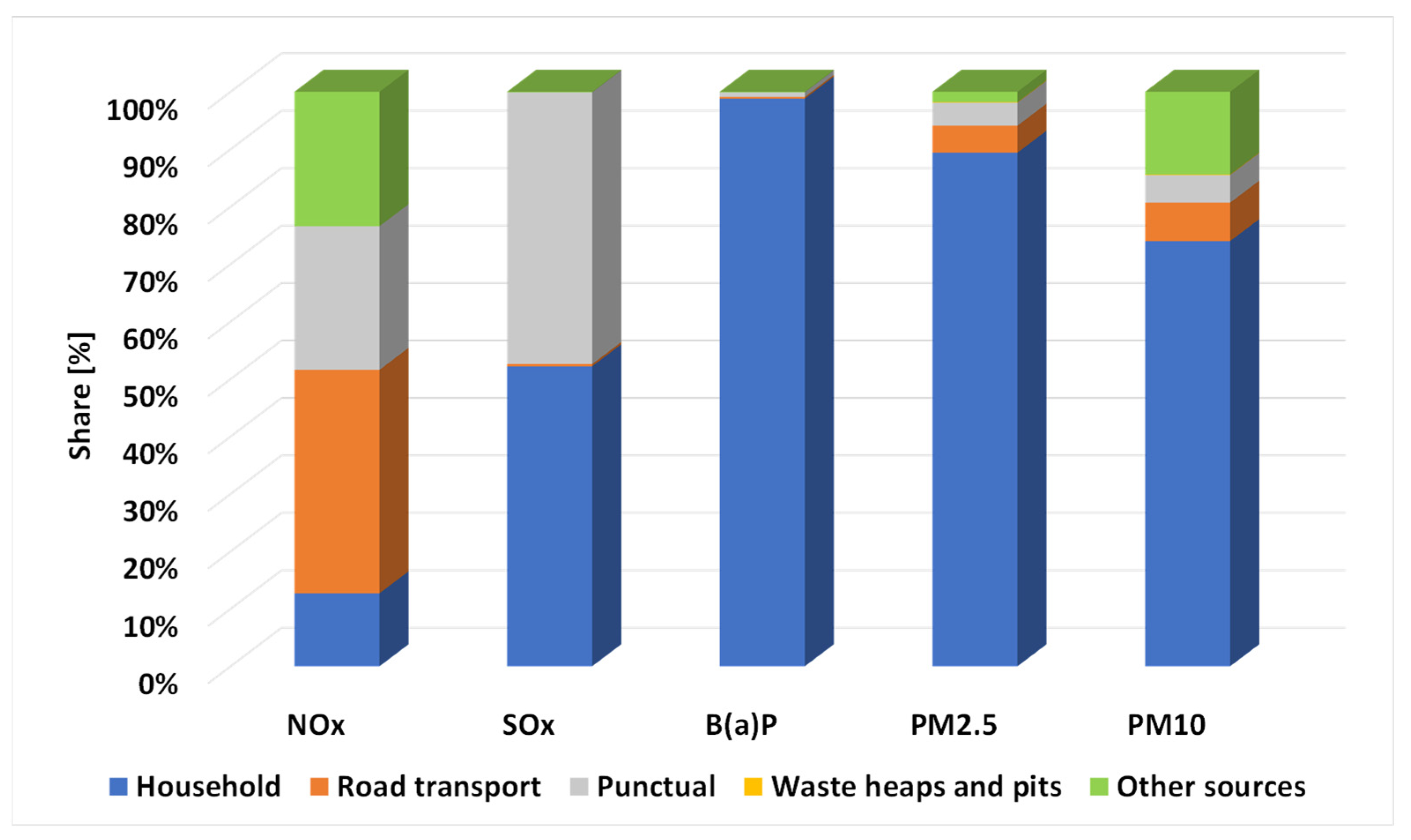
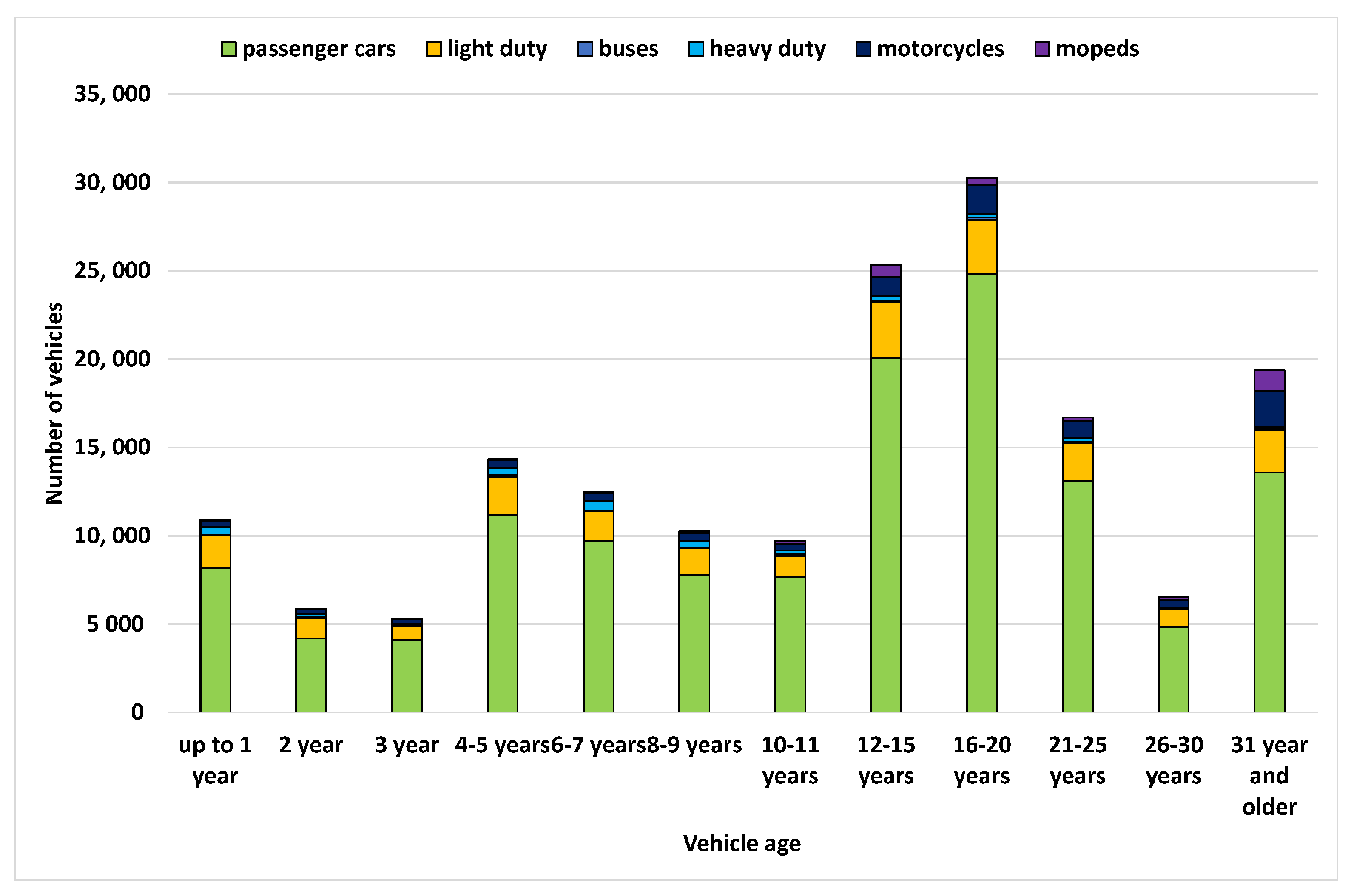
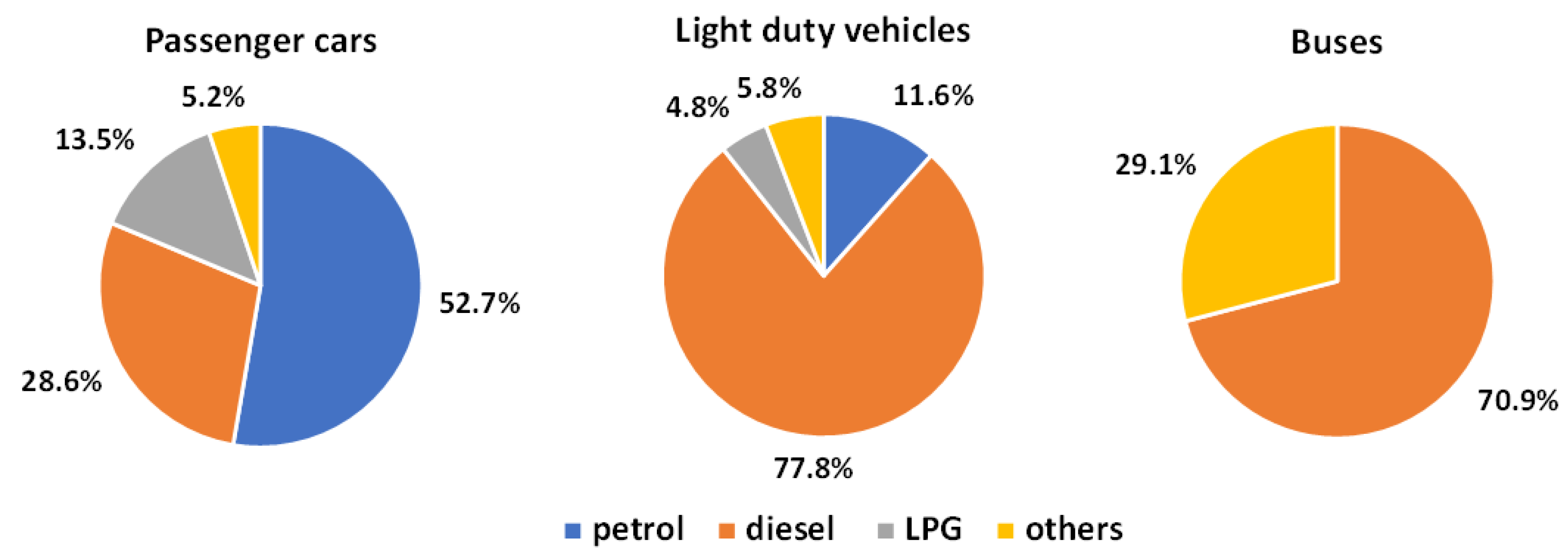
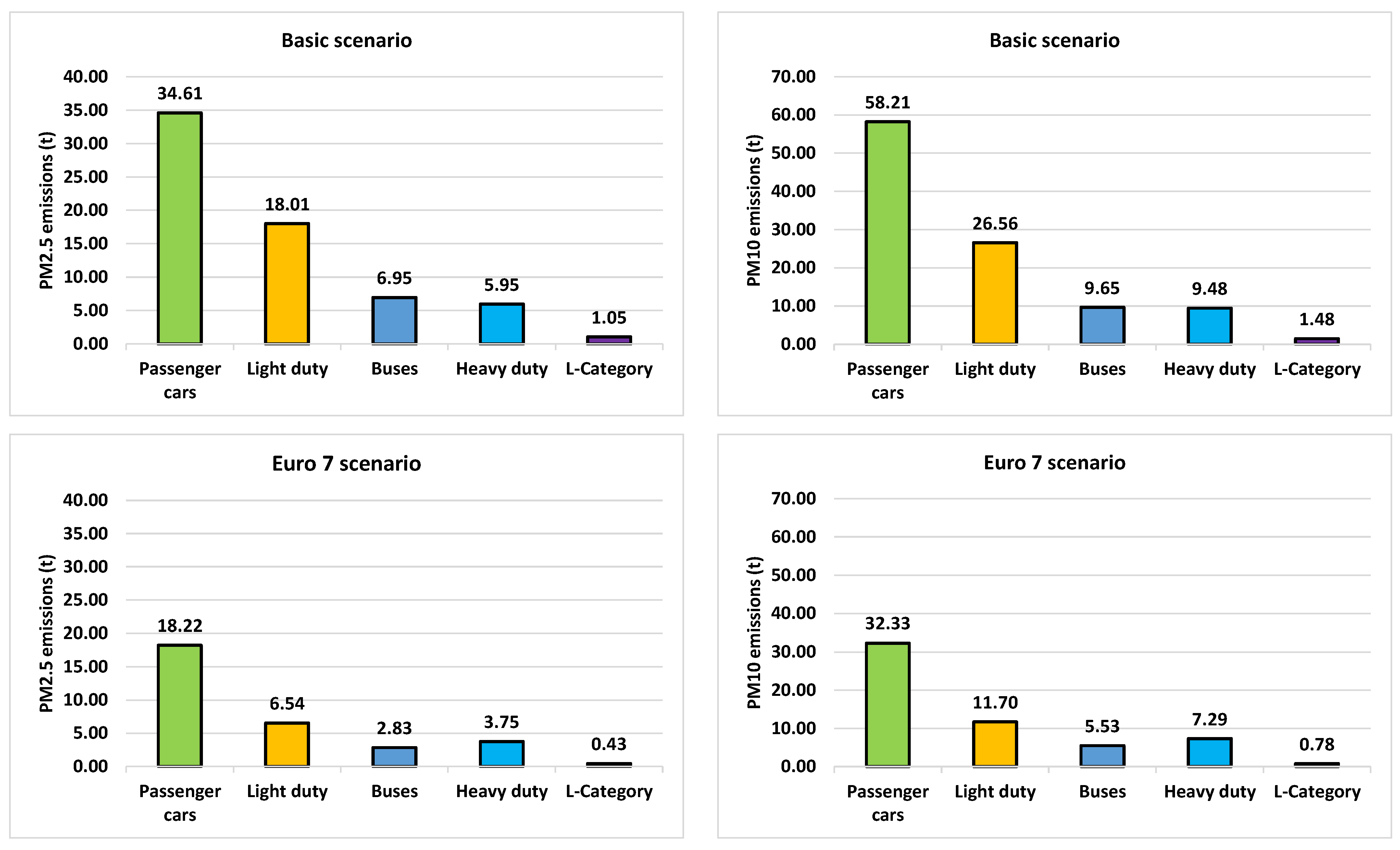
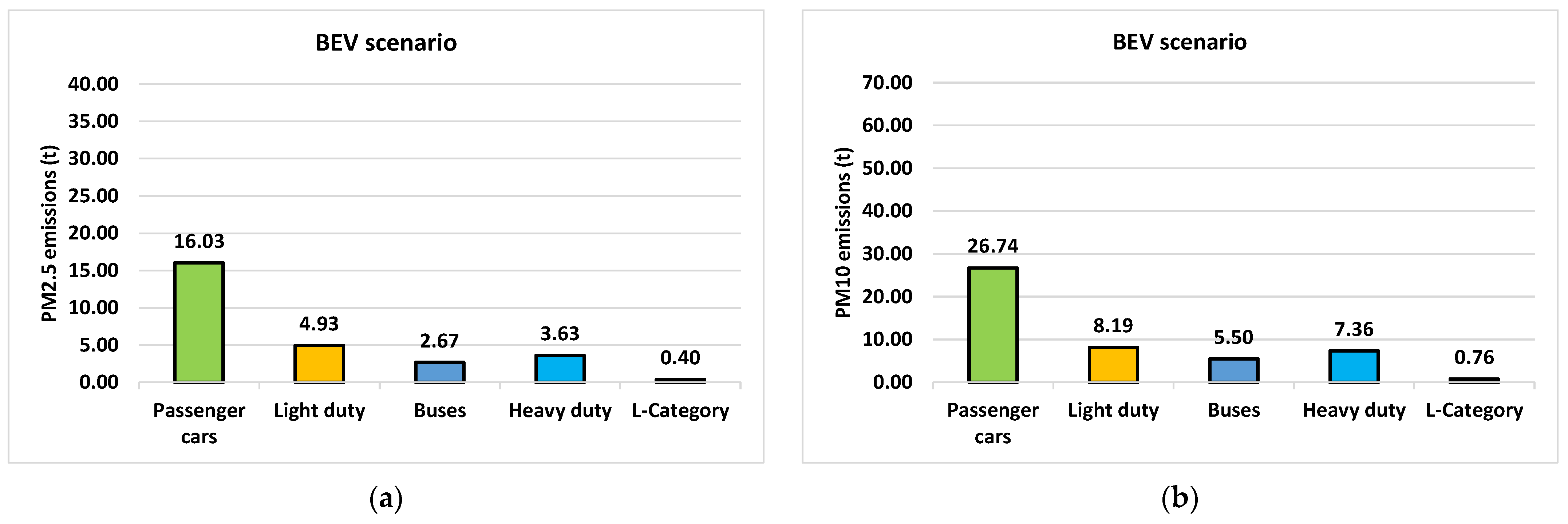

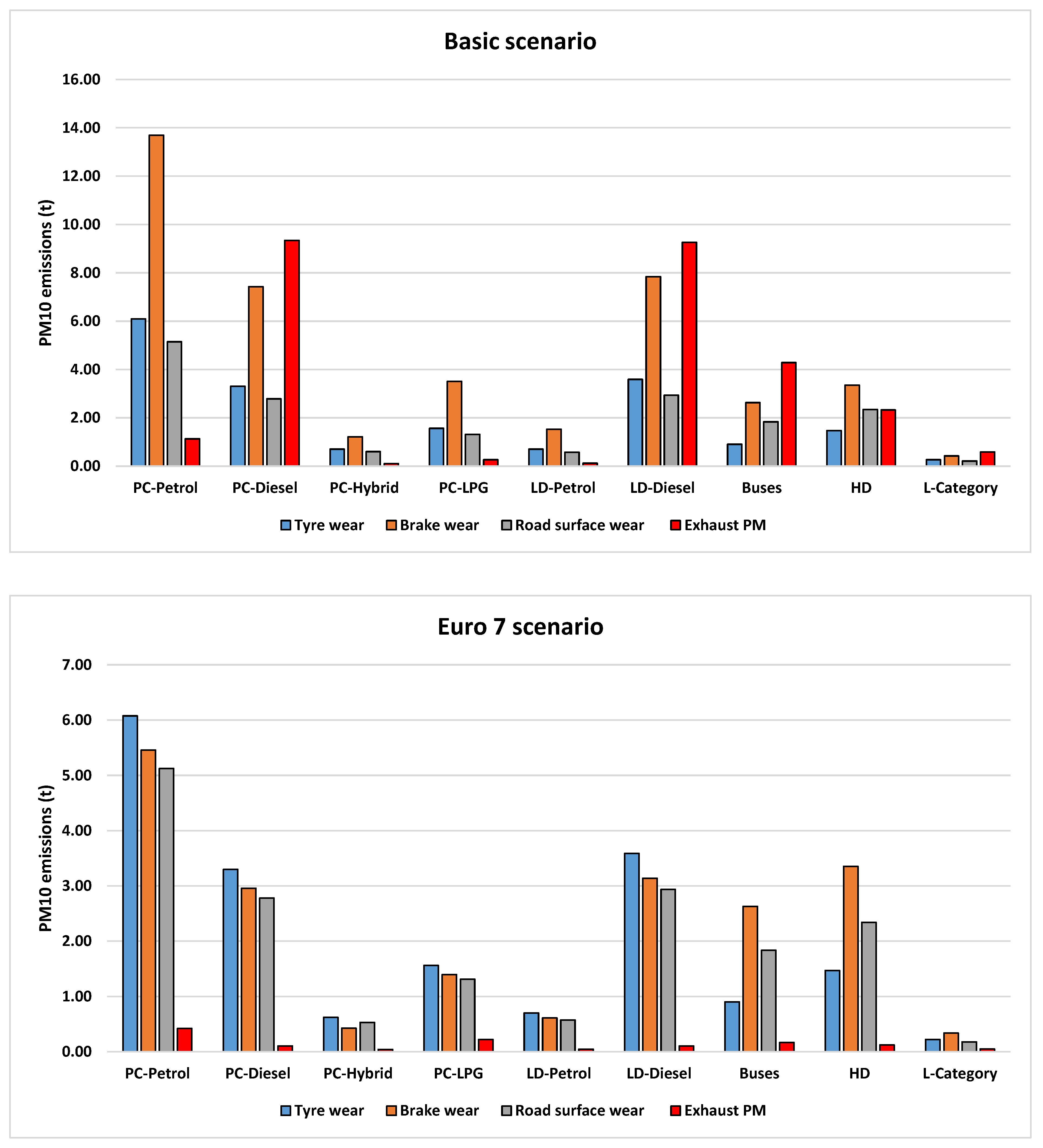




| Particle Size Class (i) | Mass Fraction (fT,i) of TSP | Mass Fraction (fB,i) of TSP | Mass Fraction (fR,i) of TSP |
|---|---|---|---|
| PM2.5 | 0.420 | 0.390 | 0.27 |
| PM10 | 0.600 | 0.980 | 0.50 |
Disclaimer/Publisher’s Note: The statements, opinions and data contained in all publications are solely those of the individual author(s) and contributor(s) and not of MDPI and/or the editor(s). MDPI and/or the editor(s) disclaim responsibility for any injury to people or property resulting from any ideas, methods, instructions or products referred to in the content. |
© 2025 by the authors. Licensee MDPI, Basel, Switzerland. This article is an open access article distributed under the terms and conditions of the Creative Commons Attribution (CC BY) license (https://creativecommons.org/licenses/by/4.0/).
Share and Cite
Jaworski, A.; Kuszewski, H.; Balawender, K.; Babiarz, B. Atmospheric Concentration of Particulate Air Pollutants in the Context of Projected Future Emissions from Motor Vehicles. Atmosphere 2025, 16, 878. https://doi.org/10.3390/atmos16070878
Jaworski A, Kuszewski H, Balawender K, Babiarz B. Atmospheric Concentration of Particulate Air Pollutants in the Context of Projected Future Emissions from Motor Vehicles. Atmosphere. 2025; 16(7):878. https://doi.org/10.3390/atmos16070878
Chicago/Turabian StyleJaworski, Artur, Hubert Kuszewski, Krzysztof Balawender, and Bożena Babiarz. 2025. "Atmospheric Concentration of Particulate Air Pollutants in the Context of Projected Future Emissions from Motor Vehicles" Atmosphere 16, no. 7: 878. https://doi.org/10.3390/atmos16070878
APA StyleJaworski, A., Kuszewski, H., Balawender, K., & Babiarz, B. (2025). Atmospheric Concentration of Particulate Air Pollutants in the Context of Projected Future Emissions from Motor Vehicles. Atmosphere, 16(7), 878. https://doi.org/10.3390/atmos16070878










